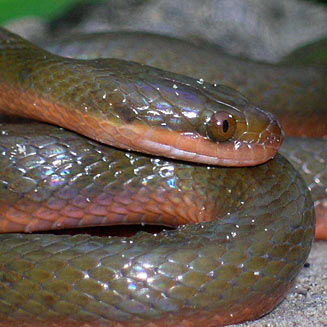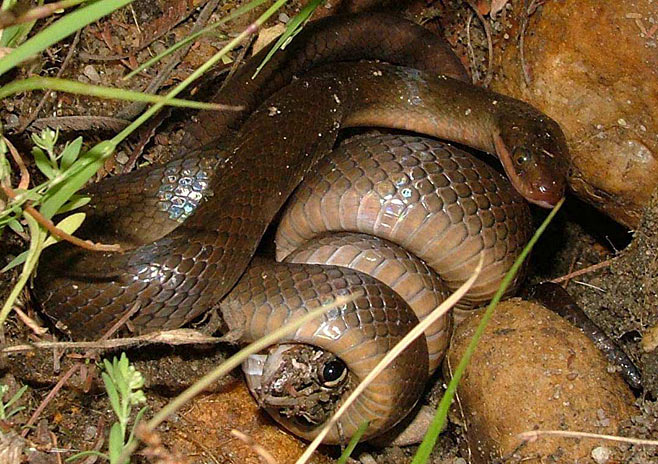|
Lycodonomorphus rufulus (Common brown water snake)
Bruinwaterslang [Afrikaans]; Ivuzamanzi elimdubu [Zulu];
Izilenzi [Xhosa]
Life >
Eukaryotes
>
Opisthokonta >
Metazoa
(animals) > Bilateria > Deuterostomia >
Chordata >
Craniata > Vertebrata (vertebrates) > Gnathostomata (jawed vertebrates) >
Teleostomi (teleost fish) > Osteichthyes (bony fish) > Class:
Sarcopterygii (lobe-finned fish) > Stegocephalia (terrestrial vertebrates) >
Tetrapoda
(four-legged vertebrates) > Reptiliomorpha > Amniota >
Reptilia (reptiles) >
Romeriida > Diapsida > Lepidosauromorpha > Lepidosauria >
Squamata > Serpentes
(snakes) > Family: Colubridae > Subfamily:
Boodontinae > Genus:
Lycodonomorphus
 |
|
Lycodonomorphus rufulus (Common brown water snake),
Western Cape, South Africa. [T. Phelps ©, from
SARCA Virtual Museum] |
 |
 |
|
Lycodonomorphus rufulus (Common brown water snake),
Western Cape, South Africa. [J. Els ©, from
SARCA Virtual Museum] |
Lycodonomorphus rufulus (Common brown water snake),
Mpumalanga, South Africa. [M. Adams ©, from
SARCA Virtual Museum] |
Identification
The Brown water snake can be identified by its uniform
olive or light brown colouration, the pink or mother of pearl coloured underside,
its good swimming ability and vertical pupils. It grows to an average length of
60 cm but may reach 85 cm.
Distribution and habitat
The distribution of this snake includes the entire western
coast line and the north eastern half of South Africa and central Zimbabwe.
Their preferred habitat includes rivers and vleis in moist savanna and lowland
forest.
Food
Eats
frogs,
tadpoles, small fish and
rodents
(e.g.
rats and mice).
 |
|
Common brown water snake next to a river in the
Western Cape, constricting a frog it had caught. After swallowing the
frog, it disappeared down a hole. [K. Marais ©, from
SARCA Virtual Museum] |
Predators, parasites and disease
Eaten by monitor lizards,
birds of
prey (e.g.
snake eagles), other snakes and
spiders.
Reproduction
Oviparous (egg-laying), lays between 6 and 23 eggs in mid
summer.
Longevity
Likely to have an average lifespan of
10 years.
Medical importance
Non-venomous and not dangerous to man and not likely to
bite, however in the Zulu culture it is regarded as extremely dangerous.
Links
References
-
Broadley, D.G. 1983. FitzSimons' Snakes of Southern
Africa. Delta Books, Johannesburg.
-
Marais, J. 2004. A Complete Guide to Snakes of Southern Africa. Struik Publishers, Cape Town.
|
